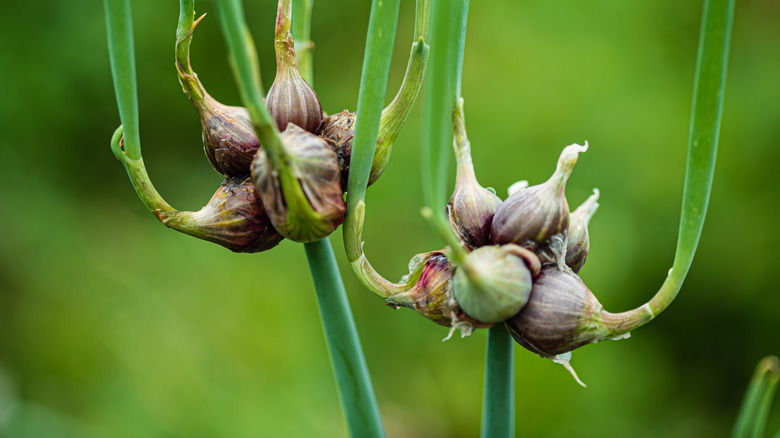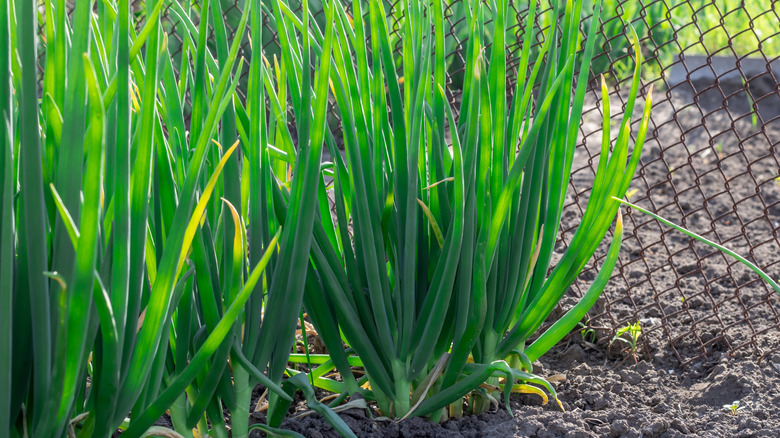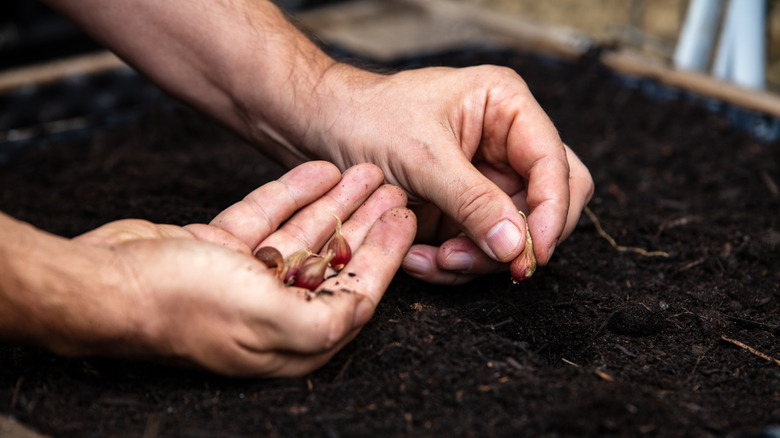Here's Why You Should Make Room For An Egyptian Walking Onion In Your Garden This Year
It's about time you break the monotony of your garden with a plant that is as cool as it sounds: the Egyptian walking onion. This plant will not only add jaw-dropping flavor to your garden's aesthetics, but also be a warrior for its overall ecosystem and a pleasure for your taste buds. With little to no maintenance headaches, plenty of culinary uses, pest-repelling properties, soil-enriching benefits, and a distinct aesthetic appeal, Egyptian walking onions rightfully deserve a corner of your garden's real estate this year.
Egyptian walking onion (Allium x proliferum), also known as topset onion or tree onion, is an easy-to-grow onion variety, uniquely known for growing clusters of bulbils instead of flowers on top of its stalk. Its spikes grow as tall as 2 feet by the end of spring and early summers and produce tiny, green edible bulbils on top. Wondering about the secret behind the weird name? Well, this perennial cross between the cultivated onion and the Welsh onion — an import originating from the Indian subcontinent — actually walks! Or at least that's what you would think if you saw its two-year long footage fast forwarded at around 100x. Here's what happens in real time though: When the weight of its bulbils becomes too much to bear for the stalks (say, if it is not harvested) it falls over to the ground, starts forming roots, and a whole new plant emerges from the spot, giving the impression that the plant has taken a walking step.
Egyptian walking onions are great for your garden's ecosystem
While the plant is a rockstar in the kitchen — you can use the green tops as an ingredient in salads and soups, pickle the bulbils or add them to stews for flavor, or caramelize mature bulbs for Italian delicacies — their unique selling prop revolves around the amazing value they add to your garden. Like all plants in the Allium genus, Egyptian walking onions possess phytochemicals with fungicidal properties, which can be especially potent against powdery mildew in veggies. All you have to do is use their leaves to make a DIY fertilizer tea to nourish your garden and spray it on other plants without worrying about harming them in any way. Egyptian walking onions also work as natural pest-repelling soldiers for your garden. They have a strong, pungent aroma which wards away pests from nearby companion plants. This, again, is especially helpful when you're fond of growing vegetables or popular crops that will attract whiteflies and other garden pests.
The plant also comes with a bunch of benefits for the soil. Its roots improve soil aeration, prevent erosion, and facilitate the movement of water and air through the soil by forming deep channels. Their decomposing foliage, stems, and bulbils enrich the soil with nutrients by adding organic matter and increase its fertility. Gardeners also love planting these onions on the borders of flower or vegetable beds to add a striking visual appeal to their gardening space. Additionally, these walking buddies will also add much-appreciated biodiversity to your garden's ecosystem and bring in a host of new pollinators and beneficial insects.
How to grow Egyptian walking onions
The ideal climate for planting Egyptian walking onion occurs during fall, and they can survive through USDA Hardiness Zones 3 to 10. They are best grown alongside carrots, beets, cabbages, and lettuce. Planting them with around 6 to 10 inches between each bulb will allow them enough room to reward you with large, pungent onions. Plant the bulbs at least 2 inches deep into the soil and make sure your plants get complete exposure to sun.
In general, onions of all types do not take well to wet soil and the walking ones are no different. Ideally, they like well-drained soil with pH levels hovering anywhere between 6.2 and 6.8. Caring for the plant is super easy because of their ability to self-propagate without being invasive. All you need to do is plant one and they will gladly take over (or walk over, in this case) from there without bothering you with the hassles of replanting. The bulbs get ready for harvesting around late summer and fall. Since the plant requires such little input with fertilizers, water, or labor, they are a fantastic addition to the overall sustainability of your garden as well as personal efforts towards reducing your carbon footprint.


